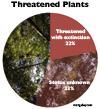
Gunung Leuser Rain Forest on the Indonesian island of Sumatra. Rainforests are the most biodiverse ecosystems in the world. Photo by: Rhett A. Butler.
A new study finds that diversity of plant species matters—big time. Analyzing nearly 600 research studies, the meta-study in the American Journal of Botany found that productivity in biodiverse plant ecosystems was 1.5 times higher than in monocultures. In other words, a prairie is more productive than a cornfield and forest more productive than a rubber plantation. The researchers warn that eroding plant diversity threatens essential ecosystems services such as food, water purification, oxygen production, carbon sequestration, and the availability of raw materials.
“The idea that declining diversity compromises the functioning of ecosystems was controversial for many years,” says marine ecologist, Emmett Duffy of the Virginia Institute of Marine Science. “This paper should be the final nail in the coffin of that controversy. It’s the most rigorous and comprehensive analysis yet, and it clearly shows that extinction of plant species compromises the productivity that supports Earth’s ecosystems.”
In addition to diverse ecosystems increasing productivity, the scientists found that such ecosystems more efficiently capture light and nutrients. Laboratory studies have also shown that diverse algae communities sequester carbon and produce oxygen twice as quickly as a single-species algae community.
According to researchers, the importance of plant diversity was consistent across the planet, spanning terrestrial, freshwater and saltwater ecosystems.
Even so the researchers admit that scientists may still be underestimating the overall importance of biodiversity. Most studies are currently done over small periods of time and in small spaces, but “data are generally consistent with the idea that the strength of diversity effects are stronger in experiments that run longer, and in experiments performed at larger spatial scales,” the scientists write.
However, as researchers discover how important diverse ecosystems much more work needs to be done.
Lead author Brad Cardinale of the University of Michigan says that future studies in plant diversity and biodiversity will help researchers “calculate the number of species needed to support the variety of processes required to sustain life in real ecosystems.”
“We don’t mean ‘need’ in an ethical or an aesthetic way. We mean an actual concrete number of species required to sustain basic life-support processes,” Cardinale clarifies.
Plants, along with many animal species, are currently threatened by a wide-variety of factors with some of the largest including deforestation, habitat loss, invasive species, pollution, and climate change.
CITATION: Cardinale, Bradley J., Kristin L. Matulich, David U. Hooper, Jarrett E. Byrnes, Emmett Duffy, Lars Gamfeldt, Patricia Balvanera, Mary I. O’Connor, and Andrew Gonzalez (2011). The functional role of producer diversity in ecosystems. American Journal of Botany 98(3): 572-592. DOI: 10.3732/ajb.1000364
Related articles
Not enough data on world’s tropical plants to predict impact of warming world

(02/14/2011) How many tropical plant species are threatened by climate change? Which plants have big enough ranges to survive a warming world, not to mention deforestation? How likely is it that the tropics are undergoing a current mass extinction? These questions may appear straight forward, but a new study in Global Change Biology finds that researchers lack the hard data necessary to come to any confident conclusions. According to the study, nine out of ten tropical plants from Africa, Asia, and South America lack the minimum number of collections needed (at least 20) to determine the species’ range, and therefore predict the impact of climate change.
Losing nature’s medicine cabinet

(10/04/2010) In all the discussions of saving the world’s biodiversity from extinction, one point is often and surprisingly forgotten: the importance of the world’s species in providing humankind with a multitude of life-saving medicines so far, as well as the certainty that more vital medications are out there if only we save the unheralded animals and plants that contain cures unknown. Already, species have provided humankind everything from quinine to aspirin, from morphine to numerous cancer and HIV-fighting drugs. “As the ethnobotanist Dr. Mark Plotkin commented, the history of medicine can be written in terms of its reliance on and utilization of natural products,” physician Christopher Herndon told mongabay.com. Herndon is co-author of a recent paper in the journal Biotropica, which calls for policy-makers and the public to recognize how biodiversity underpins not only ecosystems, but medicine.
Mass extinction fears widen: 22 percent of world’s plants endangered

(09/28/2010) Scientific warnings that the world is in the midst of a mass extinction were bolstered today by the release of a new study that shows just over a fifth of the world’s known plants are threatened with extinction—levels comparable to the Earth’s mammals and greater than birds. Conducted by the Royal Botanic Gardens, Kew; the Natural History Museum, London; and the International Union for the Conservation of Nature (IUCN), the study is the first time researchers have outlined the full threat level to the world’s plant species. In order to estimate overall threat levels, researchers created a Sampled Red List Index for Plants, analyzing 7,000 representative species, including both common and rare plants.